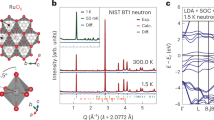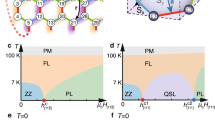Abstract
In 1929, Felix Bloch suggested that the paramagnetic Fermi sea of electrons should make a spontaneous transition to a fully magnetized state at very low densities, because the exchange energy gained by aligning the spins exceeds the enhancement in the kinetic energy1. However, experimental realizations of this effect have been hard to implement. Here, we report the observation of an abrupt, interaction-driven transition to full magnetization, highly reminiscent of Bloch ferromagnetism. Our platform utilizes the two-dimensional Fermi sea of composite fermions near half-filling of the lowest Landau level. We measure the Fermi wavevector—which directly provides the spin polarization—and observe a sudden transition from a partially spin-polarized to a fully spin-polarized ground state as we lower the density of the composite fermions. Our theoretical calculations that take Landau level mixing into account provide a semi-quantitative account of this phenomenon.
This is a preview of subscription content, access via your institution
Access options
Access Nature and 54 other Nature Portfolio journals
Get Nature+, our best-value online-access subscription
$29.99 / 30 days
cancel any time
Subscribe to this journal
Receive 12 print issues and online access
$209.00 per year
only $17.42 per issue
Buy this article
- Purchase on Springer Link
- Instant access to full article PDF
Prices may be subject to local taxes which are calculated during checkout




Similar content being viewed by others
Data availability
Data that support the plots within this paper and other findings of this study are available from the corresponding author upon reasonable request. Source data are provided with this paper.
References
Bloch, F. Z. Bemerkung zur Elektronentheorie des Ferromagnetismus und der elektrischen Leitfähigkeit. Z. Phys. 57, 545–555 (1929).
Wigner, E. On the interaction of electrons in metals. Phys. Rev. 46, 1002–1011 (1934).
Stoner, E. C. Ferromagnetism. Rep. Prog. Phys. 11, 43–112 (1947).
Attaccalite, C., Moroni, S., Gori-Giorgi, P. & Bachelet, G. B. Correlation energy and spin polarization in the 2D electron gas. Phys. Rev. Lett. 88, 256601 (2002).
Sajoto, T., Suen, Y. W., Engel, L. W., Santos, M. B. & Shayegan, M. Fractional quantum Hall effect in very-low-density GaAs/AlxGa1−xAs heterostructures. Phys. Rev. B 41, 8449–8460 (1990).
Zhu, J., Stormer, H. L., Pfeiffer, L. N., Baldwin, K. W. & West, K. W. Spin susceptibility of an ultra-low-density two-dimensional electron system. Phys. Rev. Lett. 90, 056805 (2003).
Yoon, J., Li, C. C., Shahar, D., Tsui, D. C. & Shayegan, M. Wigner crystallization and metal–insulator transition of two-dimensional holes in GaAs at B = 0. Phys. Rev. Lett. 82, 1744–1747 (1999).
Winkler, R. et al. Anomalous spin polarization of GaAs two-dimensional hole systems. Phys. Rev. B 72, 195321 (2005).
Kravchenko, S. V. & Sarachik, M. P. Metal–insulator transition in two-dimensional electron systems. Rep. Prog. Phys. 67, 1–44 (2004).
Spivak, B., Kravchenko, S. V., Kivelson, S. A. & Gao, X. P. A. Colloquium: transport in strongly correlated two-dimensional electron fluids. Rev. Mod. Phys. 82, 1743–1766 (2010).
Vakili, K., Shkolnikov, Y. P., Tutuc, E., De Poortere, E. P. & Shayegan, M. Spin susceptibility of two-dimensional electrons in narrow AlAs quantum wells. Phys. Rev. Lett. 92, 226401 (2004).
Pudalov, V. M., Kutsevich, A. Y., Gershenson, M. E., Burmistrov, I. S. & Reznikov, M. Probing spin susceptibility of a correlated two-dimensional electron system by transport and magnetization measurements. Phys. Rev. B 98, 155109 (2018).
Li, S., Zhang, Q., Ghaemi, P. & Sarachik, M. P. Evidence for mixed phases and percolation at the metal–insulator transition in two dimensions. Phys. Rev. B 99, 155302 (2019).
Vermeyen, E., Sá de Melo, C. A. R. & Tempere, J. Exchange interactions and itinerant ferromagnetism in ultracold Fermi gases. Phys. Rev. A 98, 023635 (2018).
Jain, J. K. Composite-fermion approach for the fractional quantum Hall effect. Phys. Rev. Lett. 63, 199–202 (1989).
Halperin, B. I., Lee, P. A. & Read, N. Theory of the half-filled Landau level. Phys. Rev. B 47, 7312–7344 (1993).
Jain, J. K. Composite Fermions (Cambridge Univ. Press, 2007).
Willett, R. L., Ruel, R. R., West, K. W. & Pfeiffer, L. N. Experimental demonstration of a Fermi surface at one-half filling of the lowest Landau level. Phys. Rev. Lett. 71, 3846–3849 (1993).
Kang, W., Stormer, H. L., Pfeiffer, L. N., Baldwin, K. W. & West, K. W. How real are composite fermions? Phys. Rev. Lett. 71, 3850–3853 (1993).
Willett, R. L., West, K. W. & Pfeiffer, L. N. Geometric resonance of composite fermion cyclotron orbits with a fictitious magnetic field modulation. Phys. Rev. Lett. 83, 2624–2627 (1999).
Smet, J. H. et al. Commensurate composite fermions in weak periodic electrostatic potentials: direct evidence of a periodic effective magnetic field. Phys. Rev. Lett. 83, 2620–2623 (1999).
Kamburov, D. et al. What determines the Fermi wave vector of composite fermions? Phys. Rev. Lett. 113, 196801 (2014).
Dementyev, A. E. et al. Optically pumped NMR studies of electron spin polarization and dynamics: new constraints on the composite fermion description of ν = 1/2. Phys. Rev. Lett. 83, 5074–5077 (1999).
Melinte, S. et al. NMR determination of 2D electron spin polarization at ν = 1/2. Phys. Rev. Lett. 84, 354–357 (2000).
Tracy, L. A., Eisenstein, J. P., Pfeiffer, L. N. & West, K. W. Spin transition in the half-filled Landau level. Phys. Rev. Lett. 98, 086801 (2007).
Liu, Y. et al. Spin polarization of composite fermions and particle-hole symmetry breaking. Phys. Rev. B 90, 085301 (2014).
Park, K. & Jain, J. K. Phase diagram of the spin polarization of composite fermions and a new effective mass. Phys. Rev. Lett. 80, 4237–4240 (1998).
Ortiz, G., Ceperley, D. M. & Martin, R. M. New stochastic method for systems with broken time-reversal symmetry: 2D fermions in a magnetic field. Phys. Rev. Lett. 71, 2777–2780 (1993).
Zhang, Y., Wójs, A. & Jain, J. K. Landau-level mixing and particle–hole symmetry breaking for spin transitions in the fractional quantum Hall effect. Phys. Rev. Lett. 117, 116803 (2016).
Zhao, J., Zhang, Y. & Jain, J. K. Crystallization in the fractional quantum Hall regime induced by Landau-level mixing. Phys. Rev. Lett. 121, 116802 (2018).
Mueed, M. A. et al. Reorientation of the stripe phase of 2D electrons by a minute density modulation. Phys. Rev. Lett. 117, 076803 (2016).
Hossain, M. S. et al. Direct observation of composite fermions and their fully-spin-polarized Fermi sea near ν = 5/2. Phys. Rev. Lett. 120, 256601 (2018).
Acknowledgements
We acknowledge support through the the National Science Foundation (grant DMR 1709076) for measurements and the US Department of Energy Basic Energy Science (grant DEFG02-00-ER45841), the National Science Foundation (grants ECCS 1906253 and MRSEC DMR 1420541) and the Gordon and Betty Moore Foundation’s EPiQS Initiative (grant GBMF9615) for sample fabrication and characterization. The theoretical work at Penn State (T.Z., S.P. and J.K.J.) was supported in part by the US Department of Energy, Office of Basic Energy Sciences, under grant no. DE-SC0005042. J.K.J. thanks the the Indian Institute Science, Bangalore, where part of this work was performed, for their hospitality, and the Infosys Foundation for making the visit possible. M.S. acknowledges a QuantEmX travel grant from the Institute for Complex Adaptive Matter (ICAM) and the Gordon and Betty Moore Foundation through grant no. GBMF5305. We also thank R. Warburton and R. Winkler for illuminating discussions.
Author information
Authors and Affiliations
Contributions
M.S.H. fabricated the devices, performed the measurements and analysed the data. M.S.H., M.A.M., J.K.J. and M.S. discussed the data. T.Z., S.P. and J.K.J. performed the theoretical calculations. Y.J.C., L.N.P., K.W.W. and K.W.B. grew the quantum well samples via molecular beam epitaxy. M.K.M. and K.A.V.R. helped with the measurements. M.S.H., T.Z., S.P., J.K.J. and M.S. co-wrote the manuscript with input from all co-authors.
Corresponding authors
Ethics declarations
Competing interests
The authors declare no competing interests.
Additional information
Publisher’s note Springer Nature remains neutral with regard to jurisdictional claims in published maps and institutional affiliations.
Extended data
Extended Data Fig. 1 Comparison between the patterned and unpatterned sections of the Hall bar.
Comparison between the patterned and unpatterned sections of the Hall bar. a-c, Magneto-resistance traces for four densities, taken in the patterned (a = 190 nm) and unpatterned sections, are shown. Traces are vertically offset for clarity. While we observe clear geometric resonance minima flanking ν = 1/2 in the traces taken from the section patterned with an a = 190 superlattice, the unpatterned section traces do not exhibit any such features, as expected. The cartoons in the upper panels show the spin configurations for different densities.
Supplementary information
Supplementary Information
Supplementary Discussion (Sections I–VI), Figs. 1–7 and Table 1.
Source data
Source Data Fig. 1
Numerical data used to generate graphs in the figures.
Source Data Fig. 2
Numerical data used to generate graphs in the figures.
Source Data Fig. 3
Numerical data used to generate graphs in the figures.
Source Data Fig. 4
Numerical data used to generate graphs in the figures.
Source Data Extended Data Fig. 1
Numerical data used to generate graphs in the figures.
Rights and permissions
About this article
Cite this article
Hossain, M.S., Zhao, T., Pu, S. et al. Bloch ferromagnetism of composite fermions. Nat. Phys. 17, 48–52 (2021). https://doi.org/10.1038/s41567-020-1000-z
Received:
Accepted:
Published:
Issue Date:
DOI: https://doi.org/10.1038/s41567-020-1000-z
This article is cited by
-
Ultra-high-quality two-dimensional electron systems
Nature Materials (2021)



